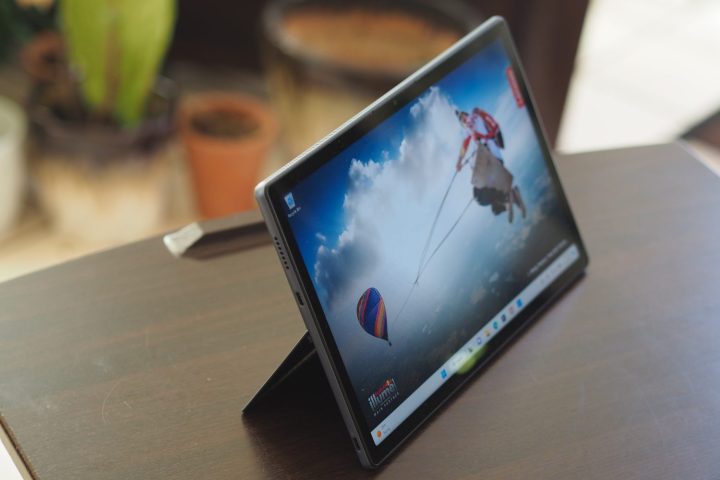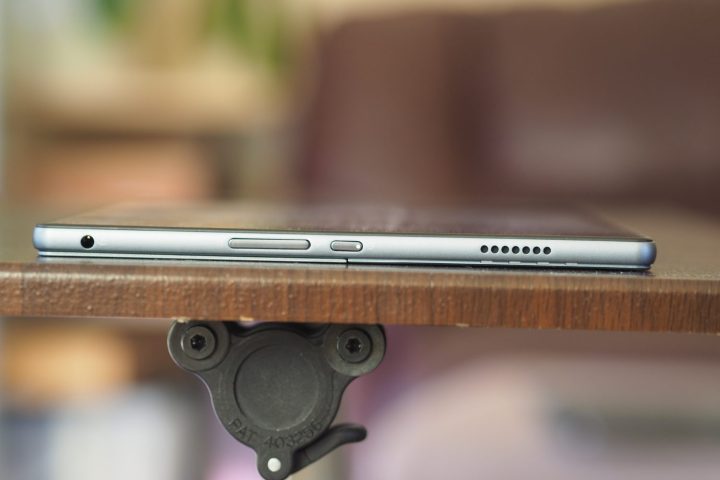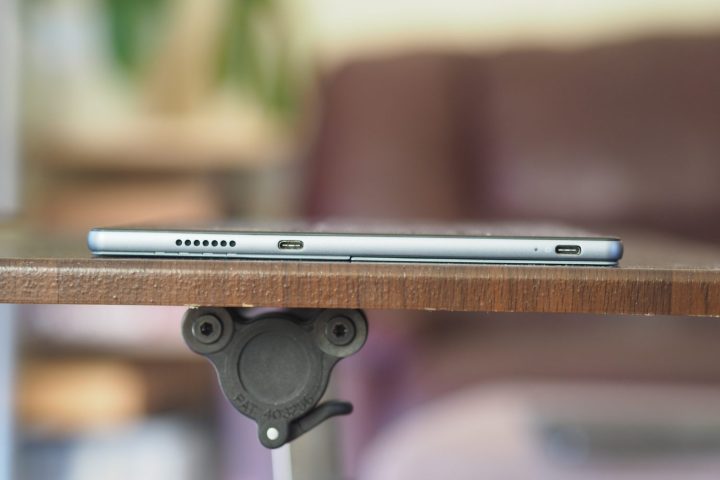- Solid build quality
- Thin and light
- Great display
- Good folio keyboard
- Competent performance
- Keyboard lies flat
- Performance limited by low-end CPU
- Colors are inaccurate
Lenovo’s IdeaPad Duet 5i was just introduced as another detachable tablet competitor, running up against the Dell XPS 13 2-in-1 and the Microsoft Surface Pro 9 that were also recently released. The hook? This one comes at a lower price than Dell and Microsoft.
The IdeaPad Duet 5i offers enough value, features, and performance to be worthy of a look, especially if you’re attracted to the form factor.
Specs and configurations
| Lenovo IdeaPad Duet 5i | |
| Dimensions | 11.35 inches x 7.49 inches x 0.37 inches |
| Weight | 1.85 pounds 2.62 pounds with folio keyboard |
| Processor | Up to Core i7-1255U |
| Graphics | Up to Intel Iris Xe |
| RAM | Up to 16GB LPDDR4x |
| Display | 12.4-inch 16:10 2.5K (2560 x 1600) IPS |
| Storage | Up to 512GB PCIe SSD |
| Touch | Yes |
| Ports | 2 x USB-C 3.2 Gen 1 1 x 3.5mm audio jack |
| Wireless | Wi-Fi 6E and Bluetooth 5.1 |
| Webcam | 5MP front-facing with IR camera for Windows 11 Hello 5MP rear-facing |
| Operating system | Windows 11 |
| Battery | 50 watt-hours |
| Price | $790+ |
Lenovo hasn’t published much information yet on pricing and configurations for the IdeaPad Duet 5i. Right now, there’s just one configuration available at $790 for a Core i3-1215U CPU, 8GB of RAM, and a 128GB SSD. That price includes the detachable keyboard but not an active pen, which is another $30 or so. That’s an attractive price, but the storage is quite limited. It’s unfortunate there’s no option for more.
In comparison, the Microsoft Surface Pro 9 is $1,000 for the same RAM and storage and a Core i5 CPU without the $280 keyboard and pen, while the Dell XPS 13 2-in-1 is $1,200 for a Core i5, the same RAM and 512GB of storage, with a keyboard and pen. That makes the Lenovo a lot less expensive in this minimal configuration, but we’ll have to see what other builds (if any) cost before assuming that the IdeaPad Duet 5i is price-competitive with more powerful components.
A functional design that doesn’t stand out

The IdeaPad Duet 5i is a standard slate design with rounded corners and larger display bezels than we’ve seen in recent competitive detachable tablets like the XPS 13 2-in-1 and Surface Pro 9. It’s more rounded than Dell’s tablet and thus more closely resembles Microsoft’s, and it’s as well-built as both with its magnesium-aluminum frame that resists bending and twisting. Like with most tablets, there’s not been much effort expended to make a standout aesthetic, and the Stone Blue or Storm Grey IdeaPad Duet 5i is neither better nor worse in this regard.
Where the IdeaPad Duet 5i most closely mimics the Surface Pro 9, and in a good way, is with its sturdy integrated kickstand. Just like with Microsoft’s tablet, the built-in kickstand levers out from the center of the tablet’s back, offering a wide range of angles. Because it’s built-in, unlike the add-on Dell folio with its three angles, The IdeaPad’s kickstand is available when using the tablet alone. That’s a huge plus and makes the IdeaPad a more comfortable tablet than the XPS 13 2-in-1.
The IdeaPad Duet 5i is a thin tablet at 0.37 inches, thicker than the XPS 13 2-in-1 and about the same as the Surface Pro 9. It weighs 1.85 pounds, again splitting the difference between those two competitors, and it’s 2.62 pounds with the folio keyboard attached. Its display bezels are a little thick, making it slightly wider and taller. It’s a nicely sized tablet all around and highly portable.

On the other hand, the IdeaPad’s detachable keyboard has the same limitation as the Dell folio: it doesn’t prop up at an angle. It’s a well-constructed keyboard with the same light, snappy switches that you’ll find on other Lenovo laptops, but because it only lies flat, it’s not as comfortable for longer typing sessions as Microsoft’s angled Type Cover. The touchpad is fine, comparable to the competition. The cloth covering the outside of the keyboard is a nice touch that makes the combination comfortable to hold.
Connectivity is limited, as usual, with just two USB-C 3.2 Gen 1 ports and no Thunderbolt 4. That sets it behind the XPS 13 2-in-1 and Surface Pro 9. Wireless connectivity is up to date, though, with Wi-Fi 6E and Bluetooth 5.1.
Video conferences are improved by the high-resolution 5MP webcam on the front and the 5MP webcam on the back, and the infrared camera provides support for Windows 11 Hello passwordless login via facial recognition. Lenovo includes its intelligent sensing privacy features that enable zero-touch lock that turns off the display and puts the tablet to sleep when the user walks away and zero-touch login that wakes up the tablet and logs in when the user returns. The features worked well during my testing, so much so that I needed to turn them off to conduct my battery tests.
Surprisingly decent performance

The IdeaPad Duet 5i I reviewed was built around a 15-watt Intel Core i3-1215U with six cores (two Performance and four Efficient) and eight threads. It’s the first laptop we’ve tested with this chip, so I was interested to see how it would perform.
Surprisingly, it held its own in our benchmark suite, particularly compared to the 9-watt Core i5-1230U in the Dell XPS 13 2-in-1 and the 15-watt Core i7-1255U in the Microsoft Surface Pro 9. Those are both 10-core (two Performance and eight Efficient), 12-thread CPUs, and the Lenovo punched above its weight class. It even beat out the XPS 13 2-in-1 in Cinebench R23. The Lenovo thermal management utility was effective, with better scores in performance mode and particularly in our Handbrake test that encodes a 420MB video as H.265. The IdeaPad does have a fan that spins up under heavy loads, but it’s quiet and unobtrusive.
There’s no doubt that this is a productivity-only laptop, suitable for web browsing, email, Microsoft Office applications, and the like. You won’t be editing photos or videos on this tablet. But for the intended uses, the IdeaPad Duet 5i was surprisingly performant. Of course, gaming is out of the question with the Intel UHD integrated graphics in my review unit. The Asus ROG Flow Z13 is the best choice if you want a Windows gaming tablet.
| Geekbench (single / multi) |
Handbrake (seconds) |
Cinebench R23 (single / multi) |
PCMark 10 Complete |
|
| Lenovo IdeaPad Duet 5i (Core i3-1215U) |
Bal: 1,513 / 5,676 Perf: 1,515 / 5,970 |
Bal: 251 Perf: 181 |
Bal: 1,488 / 4,087 Perf: 1,582 / 4,842 |
4,578 |
| Dell XPS 13 2-in-1 9315 (Core i5-1230U) |
Bal: 1,435 / 6,099 Perf: 1,572 / 7,028 |
Bal: 139 Perf: 144 |
Bal: 1,064 / 3,032 Perf: 1,065 / 3009 |
4,535 |
| Surface Pro 9 (Core i7-1255U) |
Bal: 1170 / 6518 Perf: 1,598 / 8,165 |
Bal: 166 Perf: 127 |
Bal: 1124 / 7537 Perf: N/A |
4,045 |
| HP Spectre x360 13.5 (Core i7-1255U) |
Bal: 1,566 / 7,314 Perf: 1,593 / 7921 |
Bal: 169 Perf: 120 |
Bal: 1,623 / 5,823 Perf: 1,691 / 7,832 |
5,203 |
| Asus ROG Flow Z13 (Core i9-12900H) |
Bal: 1,784 / 9,387 Perf: N/A |
Bal: 103 Perf: 87 |
Bal: 1,548 / 9,664 Perf: 1,906 / 13,400 |
6,417 |
So, did battery life follow along? The Core i3-1215U is a 15-watt part, so it’s not the most power-sipping available, but it has fewer cores and presumably runs more efficiently. There’s a 50-watt-hour battery inside, which is typical for the class. The Surface Pro 9 has 60-watt hours and a 15-watt CPU, and the XPS 13 2-in-1 has 49.5-watt-hours and a 9-watt CPU.

The IdeaPad Duet 5i did well in our suite of battery tests. It lasted longer than the XPS 13 2-in-1 and roughly the same as the Surface Pro 9 in our web browsing test. Overall, these results hint at a tablet that can get through a full day of light productivity work. As usual, the Apple MacBook Air M2 was the longevity leader.
| Web browsing | Video | PCMark 10 Applications | |
| Lenovo IdeaPad Duet 5i (Core i3-1215U) |
7 hours, 55 minutes | 10 hours, 42 minutes | 9 hours, 17 minutes |
| Microsoft Surface Pro 9 (Core i7-1255U) |
8 hours, 8 minutes | N/A | N/A |
| Dell XPS 13 2-in-1 (Core i5-1230U) |
5 hours, 55 minutes | 8 hours, 25 minutes | N/A |
| Asus ZenBook S 13 Flip (Core i7-1260P) |
8 hours, 38 minutes | 13 hours, 16 minutes | 11 hours, 18 minutes |
| HP Envy x360 13 2022 (Core i7-1250U) |
9 hours, 30 minutes | 14 hours, 34 minutes | 12 hours, 48 minutes |
| Apple MacBook Air M2 (Apple M2) |
17 hours, 59 minutes | 21 hours, 9 minutes | N/A |
A bright and colorful display, but its accuracy suffers

A good display is vital for the best tablet experience, and the IdeaPad Due 5i has a competitive IPS panel. It’s 12.4 inches running at 2560 x 1600, making it quite sharp, and its 16:10 aspect ratio is slightly taller and better for inking. The Surface Pro 9 and XPS 13 2-in-1 both enjoy 3:2 aspect ratios that are optimal for inking, closely mimicking a physical sheet of paper.
What’s most impressive about the display is its brightness, which comes in at just over 600 nits. That’s incredibly bright and higher than Microsoft’s and Dell’s tablets. The IdeaPad Duet 5i has wider colors than those two and excellent contrast. Where it falls down is in color accuracy, which isn’t great. It’s an excellent display for productivity work and for media consumption, particularly given its Dolby Vision high dynamic range (HDR) video support. Its inaccurate colors hold it back for creators, though.
| Brightness (nits) |
Contrast | sRGB gamut | AdobeRGB gamut | Accuracy DeltaE (lower is better) |
|
| Lenovo IdeaPad Duet 5i (IPS) |
605 | 1,670:1 | 100% | 90% | 2.99 |
| Microsoft Surface Pro 9 (IPS) |
409 | 1,050:1 | 99% | 80% | 1.24 |
| Dell XPS 13 2-in-1 (IPS) |
480 | 1,840:1 | 99% | 78% | 0.8 |
| Asus ZenBook S 13 Flip (OLED) |
337 | 23,590:1 | 100% | 97% | 1.02 |
| HP Envy x360 13 (OLED) |
391 | 29,420:1 | 100% | 98% | 0.72 |
Two side-firing speakers provide sound, and they put out acceptable audio that’s about equivalent to the Surface Pro 9 and XPS 13 2-in-1. Notably, Apple’s iPad Pro tablets have quad speakers and audio that’s significantly better.
A competent tablet with an almost-attractive price
The IdeaPad Duet 5i is attractively priced at $790, including its folio keyboard. That makes it significantly less expensive than the Surface Pro 9 and XPS 13 2-in-1. The downside is that the budget price brings budget components, including a slower Core i3 CPU, the slowest Intel UHD graphics, and only 128GB of storage. Dell offers four times as much storage in its entry-level configuration, and as of right now, you couldn’t upgrade even if you wanted to. And we don’t know how much the IdeaPad would cost with higher-end components.
So, that makes it a solid option as configured and priced, which is what I’m reviewing. As such, if you want a tablet that provides a bright and colorful display, solid inking and touch support, competent performance and battery life, and a comfortable kickstand, then the IdeaPad Duet 5i is an attractive choice.





